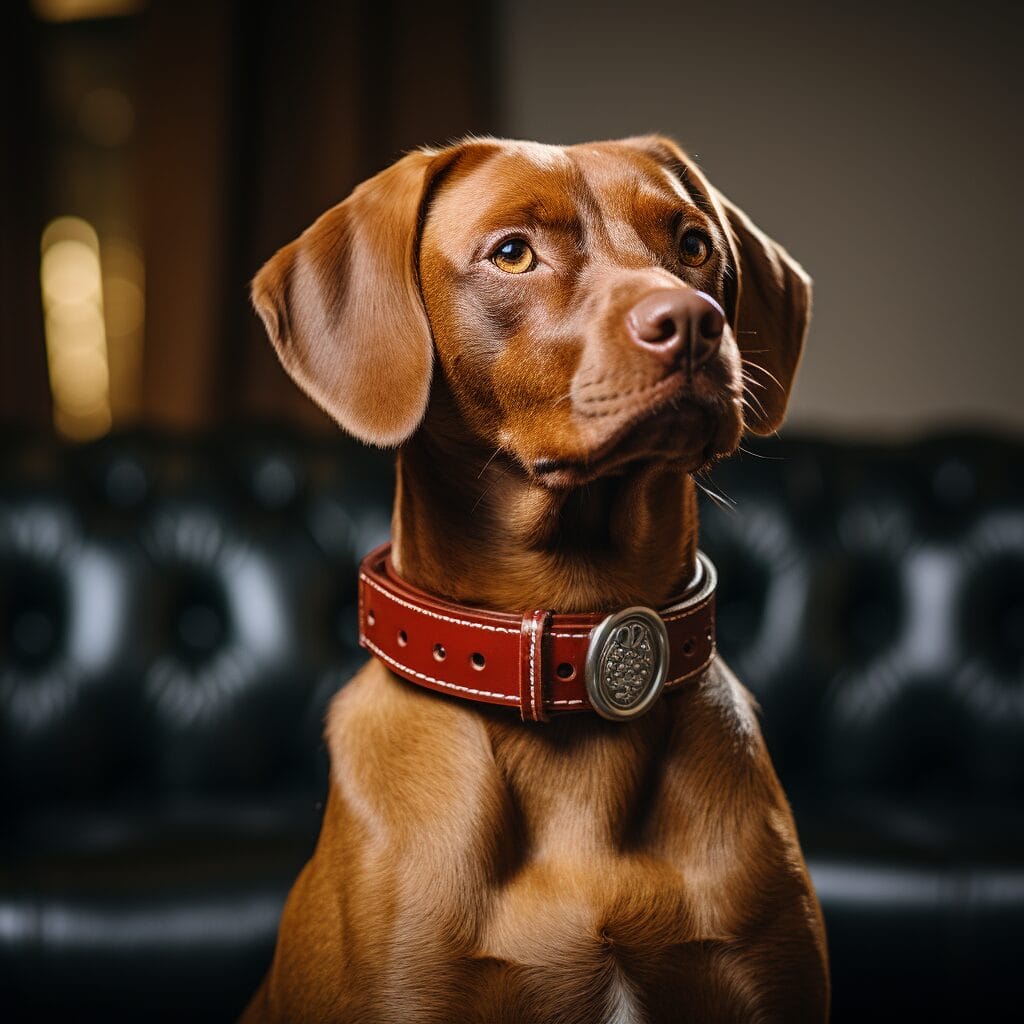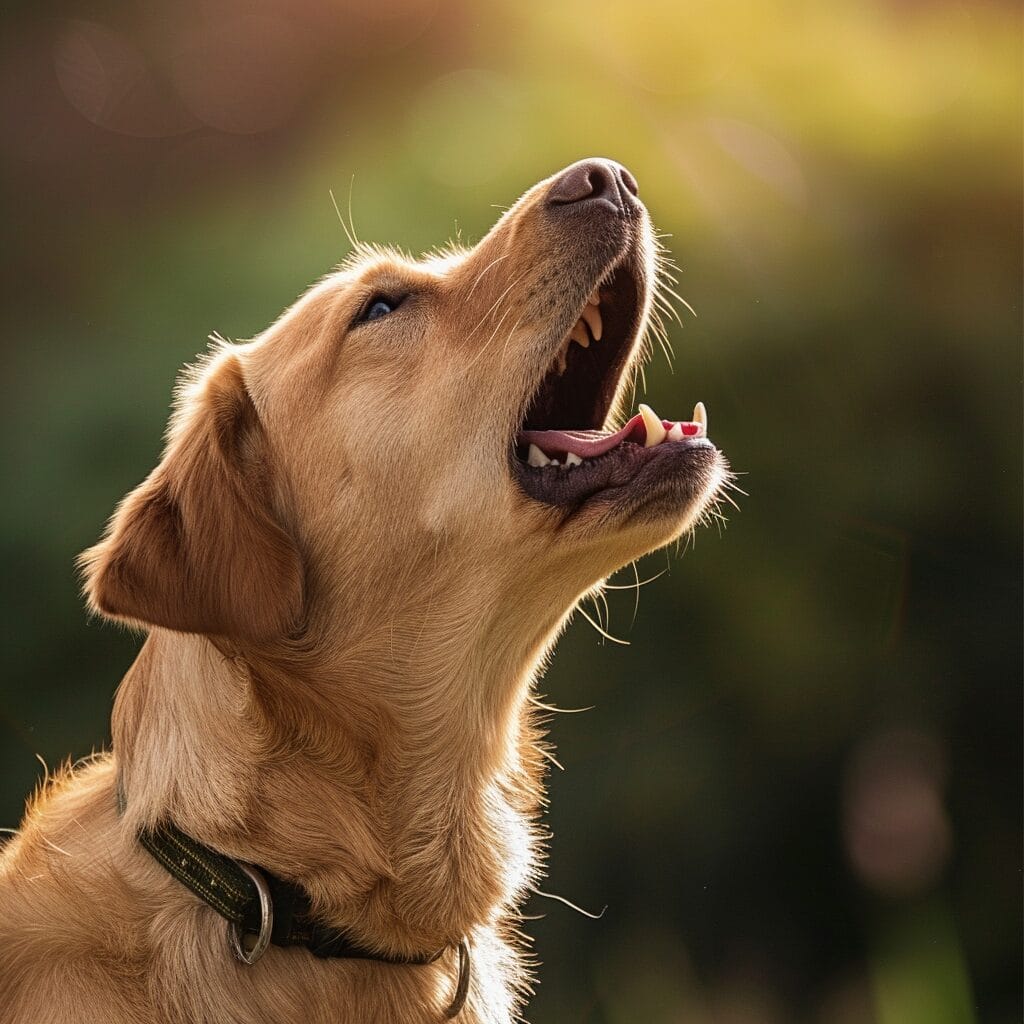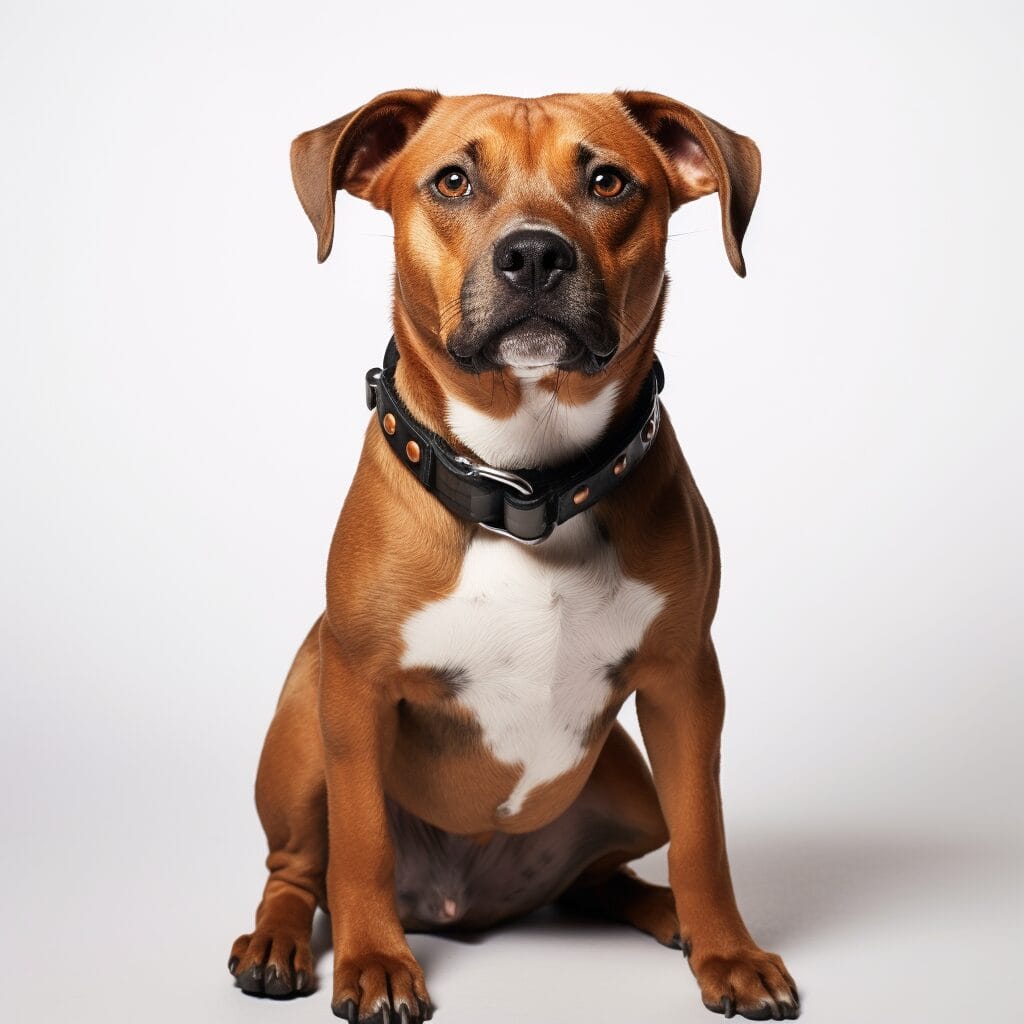A properly fitted dog collar is essential for the comfort and safety of your pup. Finding the right collar fit ensures that your pup can move comfortably while also preventing any potential harm or discomfort.
The proper fit of a pup collar directly impacts your dog’s well-being. A collar that is too loose may slip off easily, putting your pup at risk of getting lost or injured. It’s important to find the proper fit for your dog’s collar. On the other hand, a tight dog neck collar can cause discomfort, restrict breathing, and even lead to pup injury. We will discuss how to measure your dog’s neck size accurately and determine the perfect fit for their collar.
Join us as we delve into the world of fitting collars and discover how to ensure a comfortable and secure fit for your beloved canine companion, specifically focusing on the proper fit around the dog neck.
How Tight Should a Dog Collar Be?
Understanding Dog Collar Sizing Guide

Different Sizing Options for Dog Collars
It’s important to consider the various sizing options available. Dog collars typically come in different sizes, ranging from extra small to extra large. The size of the collar you choose will depend on the measurements of your dog’s neck.
Factors to Consider When Choosing the Right Size Collar
Several factors should be taken into account when selecting a collar that fits your dog perfectly. Firstly, you need to measure your dog’s neck accurately. To do this, use a soft measuring tape and wrap it around the base of their neck, where their collar would naturally sit. Make sure not to pull too tightly on your pet collar or leave any excess space.
Another factor to consider is the breed, age, and pet collar of your dog. Different breeds have different neck sizes, so it’s important to choose a collar that suits their specific needs. Puppies may require adjustable collars that can be resized as they grow.
It’s also crucial to take into account any special considerations related to your dog’s health or behavior, including the type of pet collar your dog wears. For example, if your dog has a medical condition or is prone to pulling on walks, you might need a collar with additional features such as padding or martingale-style design for better control and comfort.
Explanation of How Collar Size Affects Fit and Comfort
The size of a dog collar directly impacts its fit and comfort level for your furry friend. If the collar is too loose, it may slip off easily or get caught on objects during playtime or walks. On the other hand, if it is too tight, it can cause discomfort and even injury by putting pressure on their neck.
A properly fitted collar should allow you to slide two fingers comfortably between the collar and your dog’s neck without being too loose or tight. This ensures that the collar stays securely in place without restricting your dog’s movement or causing any discomfort.
Moreover, the right collar size is essential for effective leash training. A well-fitted collar allows you to attach a leash securely and maintain control over your dog without causing any harm or discomfort.
Types of Dog Collars and Their Uses

Overview of Various Types of Dog Collars
There are several different types of dog collars available on the market, each designed for specific purposes. Understanding the different options can help you choose the right collar for your furry friend.
- One common type of dog collar is the flat collar. These collars are made from nylon or leather and feature a buckle or snap closure. Flat collars are ideal for everyday use and can be easily adjusted to fit your dog’s neck comfortably. They come in various widths to accommodate different sizes and breeds.
- Another popular option is the martingale collar. Martingale collars have an additional loop that tightens when your dog pulls on the leash, providing gentle control without choking them. These collars are often used for dogs with narrow heads, such as Greyhounds, to prevent them from slipping out of their collar.
- Harnesses are another type of dog collar that offers a different level of control. Instead of fitting around the neck, harnesses wrap around the chest and shoulders, distributing pressure more evenly if your dog pulls on the leash. This type of collar is particularly beneficial for dogs prone to tracheal collapse or those with respiratory issues.
Explanation of Specific Uses and Benefits
Flat collars are suitable for most dogs and provide a convenient place to attach identification tags or a leash. They offer a sense of security during walks while allowing your dog freedom to move comfortably. However, it’s important to ensure that these collars fit snugly enough to prevent slipping off but not too tight as to restrict breathing or cause discomfort.
Martingale collars are excellent options for training dogs who tend to pull on their leashes. The tightening action mimics natural pack behavior, encouraging dogs to stay close without causing harm or distress. They provide effective control while still allowing your pup some freedom during walks.
Harnesses offer superior control over your dog’s movements, especially if they tend to pull or have neck-related issues. By distributing the pressure across the chest and shoulders, harnesses reduce strain on the neck and throat. They are a popular choice for small breeds, brachycephalic dogs (short-nosed breeds), or those recovering from surgery.
Importance of Selecting the Appropriate Collar Type
Choosing the right collar type is crucial for your dog’s comfort and safety. Each collar serves a specific purpose, so it’s essential to consider your dog’s individual needs when making a selection.
How to Measure Your Dog for a Collar
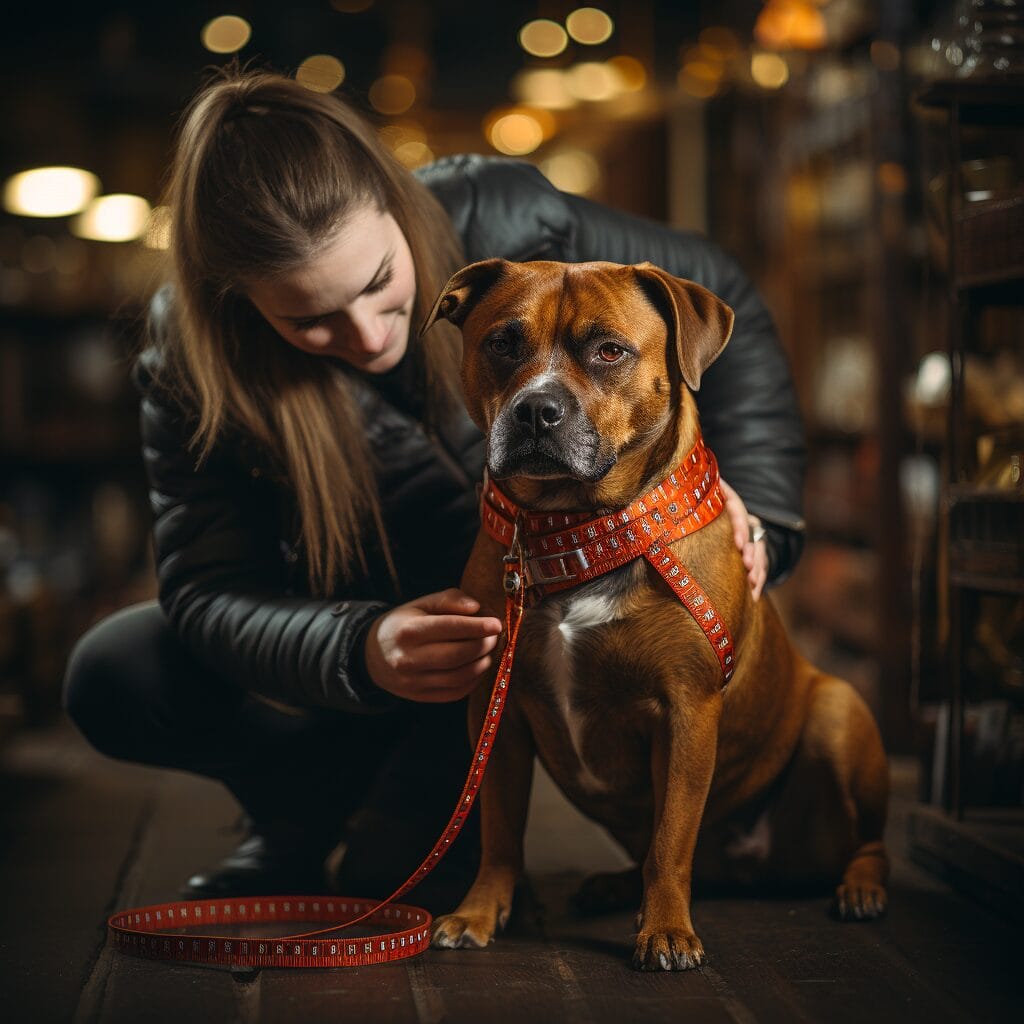
Step-by-step Guide on Measuring Your Dog’s Neck
To ensure that your dog’s collar fits properly and comfortably, it is essential to measure their neck accurately. Here is a step-by-step guide to help you measure your dog’s neck circumference:
- Gather the necessary tools: Grab a flexible measuring tape or a piece of string and a ruler. Make sure the measuring tape or string is long enough to go around your dog’s neck.
- Prepare your dog: Find a quiet and calm area where you can easily access your dog’s neck without distractions. Have some treats handy to reward your furry friend for their cooperation.
- Position the measuring tape: Place the measuring tape or string around the base of your dog’s neck, right where their collar usually sits. Make sure it is snug but not too tight, allowing you to slide two fingers between the tape/string and their skin.
- Take the measurement: Read the number on the measuring tape or mark the spot where the string overlaps with itself using a pen or small piece of tape. This measurement represents your dog’s neck circumference.
- Double-check for accuracy: Repeat the process at least once more to ensure accuracy, as measurements can vary slightly due to different positions and movements.
Tips for Accurate Measurements and Ensuring a Proper Fit
Obtaining accurate measurements is crucial when choosing an appropriately fitting collar for your beloved pup. Here are some tips to help you achieve accurate measurements and ensure a proper fit:
- Measure when your dog is calm: Dogs may have different neck sizes depending on whether they are excited, anxious, or relaxed. It is best to measure when they are in a calm state for more consistent results.
- Consider fur length: If your dog has long fur, make sure to push it aside gently before measuring their neck. This will help you get a more accurate measurement without including excessive fur in the collar’s fit.
- Allow for growth: If you have a puppy or a young dog, consider choosing an adjustable collar that can accommodate their growth. Ensure there is enough room to fit two fingers comfortably between the collar and your dog’s neck.
- Check for tightness: After putting on the collar, ensure it is not too tight by sliding two fingers underneath. This allows for proper airflow and prevents discomfort or injury to your furry friend.
The Two-Finger Rule for Dog Collar Tightness

Explanation of the two-finger rule for determining slip collar tightness and proper fit
Finding the ideal tightness for their dog collar is crucial. One commonly used guideline is known as the “two-finger rule.” This rule provides a simple method to determine if a dog’s collar is properly fitted.
The two-finger rule involves checking the snugness of the collar by inserting two fingers between the collar and your dog’s neck. Ideally, you should be able to fit two fingers comfortably under the collar without it being too loose or too tight. This allows for proper mobility while still providing enough security.
How to check if nylon collars are the ideal tightness or too loose or too tight
To ensure that your dog’s collar is not too loose, gently slide two fingers underneath the collar. If you can easily fit more than two fingers or if there is excessive slack, it indicates that the collar needs tightening. A loose collar may slip off or cause discomfort for your canine companion during walks or playtime.
On the other hand, if you struggle to insert two fingers beneath the collar or if it feels excessively tight, it suggests that the collar is too constricting. A tightly fitted collar can lead to discomfort, chafing, and even potential injury to your dog’s neck area.
By adhering to the two-finger rule, you can strike a balance between comfort and security for your four-legged friend. It ensures that they have freedom of movement while preventing any potential harm caused by an ill-fitting collar.
Benefits of maintaining proper collar tightness
According to the two-finger rule for slip collars and lighted collars are crucial for dog neck health and comfort. Whether for casual wear or training purposes, ensuring the right fit is essential.
Maintaining proper collar tightness based on the two-finger rule offers several benefits for both you and your furry companion. Firstly, it helps prevent accidents such as collars getting caught on objects due to excessive slack. A properly fitted collar reduces the risk of your dog slipping out of their collar, ensuring they remain safe and secure during walks or outdoor activities.
A well-fitted collar promotes comfort for your dog. It prevents unnecessary rubbing or irritation that can occur when a collar is either too loose or too tight. By avoiding discomfort, your dog will be more at ease and enjoy their daily adventures to the fullest.
Moreover, following the two-finger rule allows you to easily identify when it’s time to adjust the collar as your dog grows.
Risks of Incorrectly Fitted Dog Collars

Potential dangers associated with an ill-fitting dog collar
An ill-fitting dog collar can pose various risks to the well-being of our furry friends. One significant danger is the potential for injuries caused by a tight collar. When a collar is too tight, it can restrict the dog’s breathing and cause discomfort. This can lead to respiratory issues, such as difficulty breathing or even choking. A tight collar can put pressure on the neck and throat, potentially resulting in damage to the delicate structures in that area.
On the other hand, if a dog collar is too loose, there is an increased risk of accidental slipping off or getting caught on objects while exploring outdoors. This can lead to dangerous situations where dogs may become entangled or injured.
Negative impacts on a dog’s comfort, behavior, and health
An incorrectly fitted dog collar not only poses physical risks but also affects a dog’s overall comfort and behavior. Dogs are highly sensitive creatures, and discomfort caused by an improperly fitted collar can result in behavioral changes. For instance, some dogs may become anxious or stressed due to constant irritation from a tight collar. This anxiety can manifest through behaviors like excessive scratching or pawing at their necks.
Furthermore, an uncomfortable collar can hinder proper training and socialization efforts. Dogs may associate discomfort with certain activities or environments and develop negative associations over time. This could impede their ability to learn commands effectively or interact positively with other animals and humans.
Moreover, an ill-fitting collar can have detrimental effects on a dog’s skin health. A tight collar may rub against the skin, causing irritation, redness, rashes, or even open sores if left unaddressed. These skin issues not only cause discomfort but also increase the risk of infection if bacteria enter through broken skin.
Examples of common problems caused by incorrectly fitted collars
There are several common problems that can arise from incorrectly fitted dog collars. One example is the formation of matting or fur loss around the neck area. A tight collar can cause friction against the fur, leading to tangles and matting. Similarly, a loose collar may allow hair to get caught and pulled, resulting in patchy fur loss.
Another issue is the formation of calluses or pressure sores on the skin beneath a tight collar. The constant pressure exerted by an ill-fitting collar can lead to thickened skin areas that are prone to irritation and discomfort.
Signs of an Ill-Fitting Dog Collar
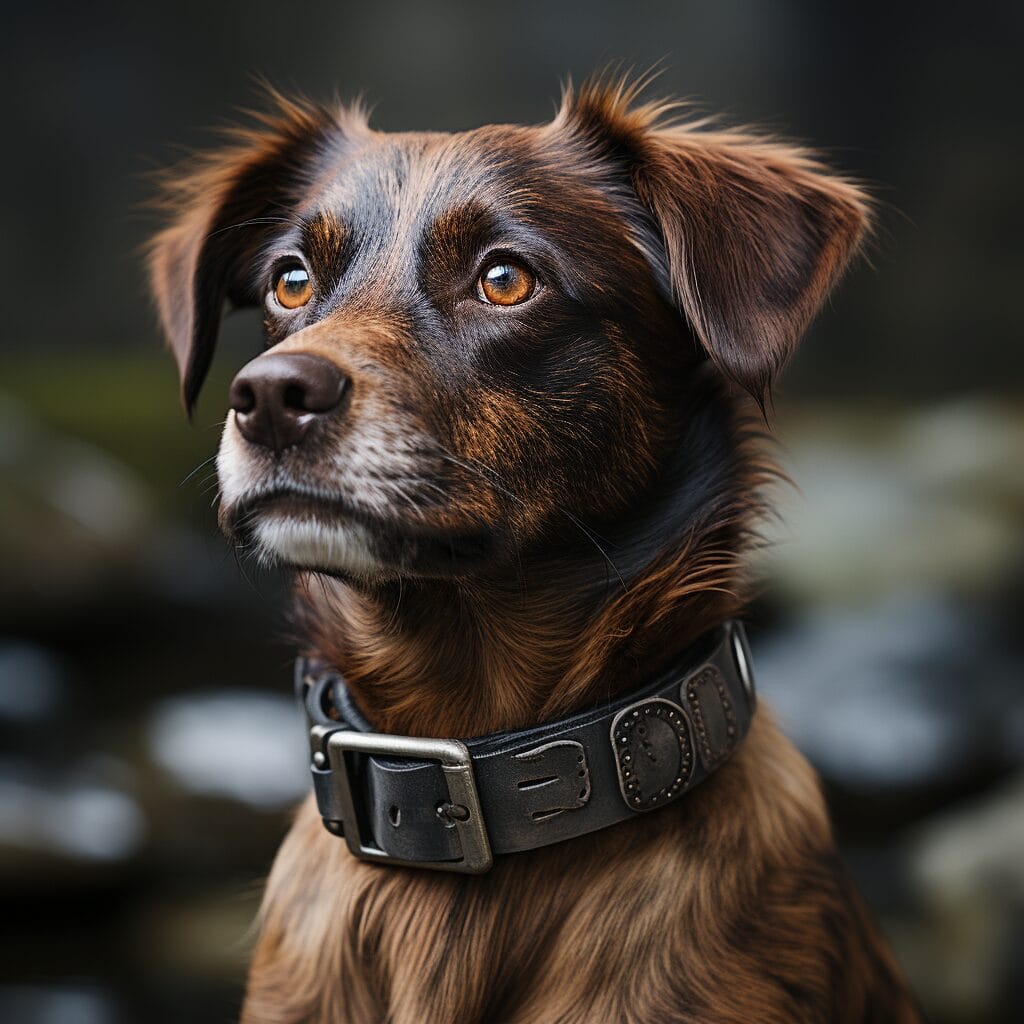
Observable Signs Indicating a pup’s slip collar is Not Fitting Properly Slip collars have their disadvantages, and one of them is when they don’t fit the pup properly. It’s important to pay attention to observable signs that indicate the slip collar is not fitting correctly. One common issue is when the textile material of the collar is too loose or too tight around the pup’s neck.
- One important aspect to consider is the fit of their collar. An ill-fitting dog collar can lead to various issues that can impact your dog’s well-being. There are several signs you can observe that indicate a dog’s collar is not fitting properly.
- Firstly, pay attention to any visible skin irritation or injury around your dog’s neck. If you notice redness, chafing, or hair loss in the area where the collar sits, it may be a clear indication that the collar is too tight or rubbing against their skin. This discomfort can cause irritation and even lead to more serious problems if left unaddressed.
- Another observable sign is when your dog consistently tries to scratch or rub their neck against objects like furniture or the ground. This behavior could be an attempt to relieve discomfort caused by an ill-fitting collar. Dogs may also try to remove their collar by pawing at it excessively or trying to slip out of it altogether.
- Behavioral changes or discomfort exhibited by pups wearing poorly fitted collars can be concerning. Dogs may show signs of distress or agitation due to the discomfort caused by ill-fitting collars. It is important to ensure that the collar fits properly to avoid any negative effects on the pup’s well-being.
- In addition to physical signs, dogs wearing collars that do not fit properly may exhibit behavioral changes indicating their discomfort. For instance, they may become more anxious or agitated than usual. They might display signs of distress such as excessive panting, pacing, drooling, or whining when wearing the collar.
- Furthermore, an ill-fitting collar can restrict a dog’s movement and hinder their ability to breathe comfortably. This restriction can cause discomfort and potentially affect their overall behavior and temperament. Dogs may become less active and refuse activities they once enjoyed due to the discomfort caused by an improperly fitted collar.
- The Importance of Regularly Checking for Signs of an Ill-Fitting Slip Collar on a Dog’s Neck Regularly checking for signs of an ill-fitting slip collar is crucial to ensure the well-being of your pup.
- Regularly checking for signs of an ill-fitting collar is crucial to ensure your dog’s well-being. By paying attention to any observable signs, you can address the issue promptly and prevent further discomfort or injury.
- To avoid skin irritation, chafing, and injury, it is essential to periodically assess the fit of your dog’s collar. You should be able to easily slip two fingers between the collar and your dog’s neck. This ensures a comfortable fit that allows room for movement without being too loose or tight.
Specialized and Purpose-Based Dog Collars

Specialized dog collars have been developed to meet the unique needs of dogs in various situations. These collars are designed with specific purposes in mind, such as training, safety, or tracking. One type of specialized collar is the training collar, which helps owners teach their dogs proper behavior and obedience. Another popular option is the GPS collar, which allows pet parents to keep track of their furry friends’ whereabouts.
Explanation of how these collars differ from regular collars
Unlike regular dog collars that are primarily used for identification or casual wear, specialized dog collars serve a specific function. Training collars, for example, often feature different mechanisms like prongs or vibrations that help communicate with the dog during training sessions. GPS collars usually come equipped with tracking devices that use satellite technology to monitor a dog’s location in real-time.
Benefits and considerations when using specialized dog collars
Specialized dog collars offer several benefits depending on their purpose. For training collars, they can be an effective tool in teaching dogs proper behavior and reinforcing commands. The use of GPS collars provides peace of mind for pet owners by allowing them to locate their pets quickly if they go missing.
- When considering using specialized dog collars, it is important to keep certain factors in mind. First and foremost, it is crucial to choose the right size collar for your dog’s neck to ensure a comfortable fit without causing any restriction or discomfort. This is especially important for small dogs who may be more sensitive to tightness around their necks.
- Secondly, consider your dog’s breed and temperament when selecting a specialized collar. Some breeds may respond better to certain types of training methods or may require different levels of stimulation from training devices. It’s essential to research and consult professionals if needed before deciding on a particular collar.
- Lastly, the material of the collar should be considered. Nylon collars are lightweight and durable, making them suitable for everyday use. Leather collars provide a classic look and tend to be more comfortable over time as they soften with wear. Chain collars can be effective for training purposes but should be used with caution to avoid injury.
Alternatives to Traditional Dog Collars
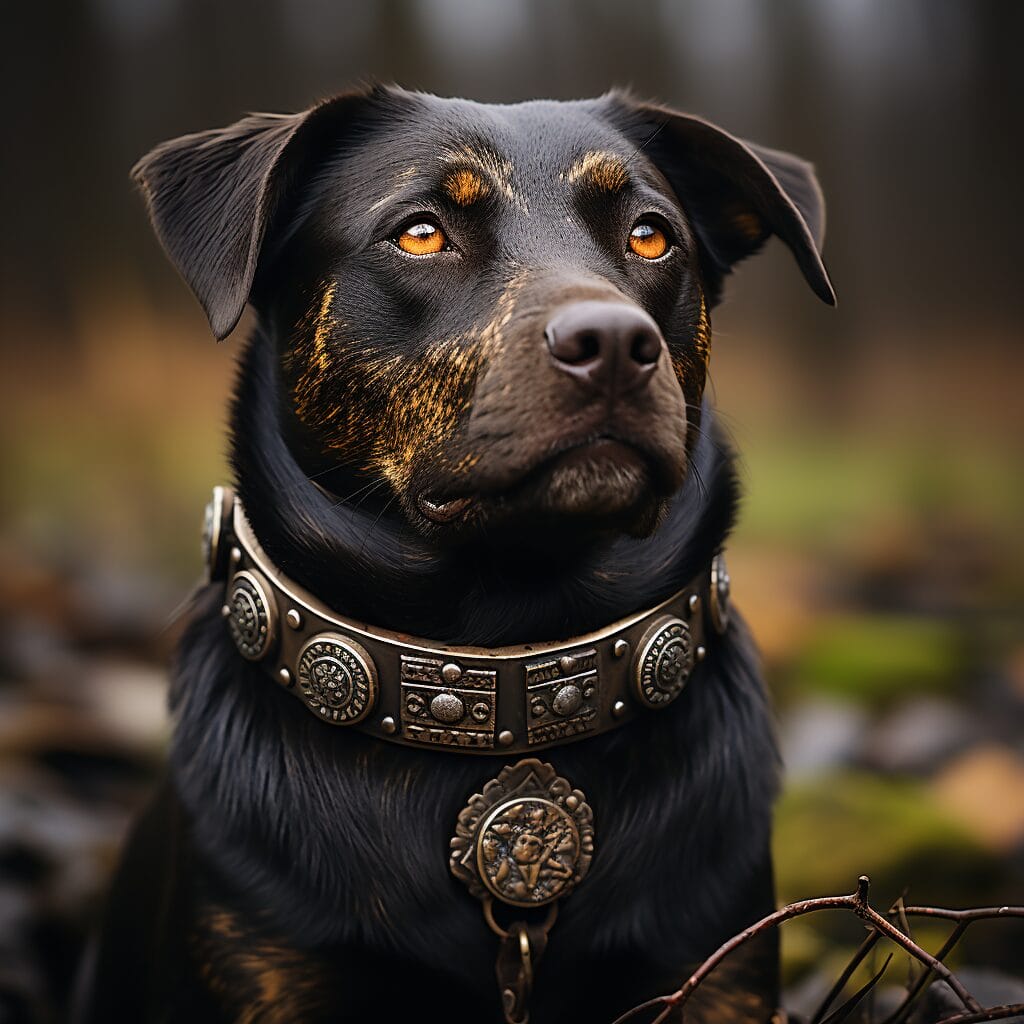
Traditional collars are not the only option available. There are several alternative options that can provide a more comfortable and effective way to control your furry friend. Two popular alternatives to traditional dog collars are harnesses and head halters.
A harness is a type of restraint that wraps around the dog’s body, distributing the pressure more evenly compared to a collar. It typically consists of straps that go around the chest and shoulders, with a leash attachment on the back or front. Harnesses are particularly beneficial for dogs with respiratory issues or neck injuries as they minimize strain on these areas.
On the other hand, head halters work by gently controlling the dog’s head movement, similar to how a horse is guided by its reins. They have a strap that goes around the dog’s muzzle and another behind their ears, providing control without causing discomfort or pain. Head halters can be an excellent choice for dogs that tend to pull on walks or exhibit aggressive behavior.
Comparison of Benefits and Drawbacks
Each alternative has its own set of benefits and drawbacks that should be considered when deciding which one is best for your dog.
Harnesses offer better control over your dog’s movements since they distribute pressure more evenly across their body. This can be particularly useful for larger or stronger dogs who tend to pull on walks. Harnesses are less likely to cause injury or discomfort compared to collars, making them suitable for dogs with certain health conditions. However, some dogs may find wearing a harness restrictive at first and may need time to adjust.
Head halters provide gentle control over your dog’s head movements without causing harm or discomfort. They can be effective in preventing pulling during walks and help redirect attention away from distractions. However, it is important to introduce head halters gradually and ensure proper fitting as improper use can lead to discomfort or injury. Some dogs may also resist wearing a head halter initially, requiring patience and positive reinforcement.
Factors to Consider
When choosing an alternative to traditional dog collars, there are a few things to consider. Firstly, take into account the size and breed of your dog. Certain alternatives may be more suitable for specific sizes or breeds. For instance, if your dog tends to pull on their leash, it is often recommended to use a harness with a front leash attachment. This can help discourage pulling behavior.
Regular Maintenance of Dog Collars

Importance of regularly cleaning and inspecting dog collars
Regularly cleaning and inspecting your dog’s collar is crucial for their comfort, safety, and overall well-being. Over time, dirt, grime, and bacteria can accumulate on the collar’s surface, leading to discomfort or even skin irritation for your furry friend. By keeping the collar clean, you can prevent these issues and ensure that your dog remains happy and healthy.
Cleaning the collar is a simple process that can be done with mild soap and warm water. Gently scrub the collar using a soft brush or cloth to remove any dirt or debris. Rinse it thoroughly to remove all soap residue before allowing it to air dry completely. It’s important not to use harsh chemicals or bleach as they may damage the collar’s material.
In addition to regular cleaning, inspecting the collar is equally important. Check for any signs of wear and tear such as frayed edges or loose stitching. These issues can compromise the integrity of the collar and affect its ability to provide a secure fit. If you notice any damage, it may be time to replace the collar to ensure your dog’s safety.
Tips for proper maintenance and care
Tips for proper maintenance and care to prolong the lifespan of a dog neck collar. Proper care is essential to ensure the durability and longevity of your pup’s collar. By following these tips, you can keep your dog neck collar in great condition for years to come.
To prolong the lifespan of your dog’s collar, there are several maintenance tips you should keep in mind:
- Remove the collar when not in use: Taking off your dog’s collar during rest periods can help prevent unnecessary wear and tear.
- Avoid exposure to excessive moisture: While some collars are designed to be waterproof, prolonged exposure to moisture can still lead to deterioration over time. Remove the collar before swimming or bathing your dog if it is not specifically designed for water activities.
- Store properly when not in use: When not being used, store the collar in a cool, dry place away from direct sunlight. This will help prevent fading or weakening of the material.
- Rotate between collars: If you have multiple collars for your dog, consider rotating them regularly. This allows each collar to have a break and reduces the chances of wear and tear from constant use.
Conclusion
In conclusion, ensuring your dog’s comfort and safety. Properly fitting a dog collar not only prevents discomfort but also reduces the risk of injury or accidents. By understanding the sizing guide, measuring your dog correctly, and following the two-finger rule for tightness, you can ensure that the collar fits snugly without being too tight. It is crucial to be aware of the signs of an ill-fitting collar and consider specialized or purpose-based collars if needed. Regular maintenance of the collar also plays a role in keeping your dog safe and comfortable.
Frequently Asked Questions
Why does your dog need a collar?
A dog needs a collar for identification purposes, as it allows for easy attachment of ID tags with contact information. It also serves as a means to attach a leash during walks and training sessions, ensuring better control and safety.
How do you adjust the fit of a dog collar for a pup?
To adjust the fit of a dog collar, ensure that it is snug yet comfortable. Use the two-finger rule: you should be able to slide two fingers between the collar and your dog’s neck. This ensures that it is not too tight or too loose, providing both comfort and security.
Why is regularly checking and adjusting collar tightness important?
Regularly checking and adjusting collar tightness is crucial to ensure your dog’s comfort and safety. Dogs grow over time, so their collars may become too tight if not adjusted accordingly. An ill-fitting collar can cause discomfort, skin irritation, or even injury to your furry friend.
What are the risks of incorrectly fitted dog collars?
Incorrectly fitted dog collars can pose various risks. If too loose, dogs may slip out of their collars and potentially get lost or injured. On the other hand, if too tight, collars can restrict breathing or cause discomfort. Proper fitting is essential to prevent these risks and promote your dog’s well-being.
Are there alternatives to traditional dog collars?
Yes, there are alternative options to traditional dog collars. Some alternatives include harnesses (which distribute pressure more evenly), head halters (which provide better control), or even GPS tracking devices attached to your pet’s collar for added safety measures. Consider consulting with a professional trainer or veterinarian for guidance on choosing the right option for your specific needs.

